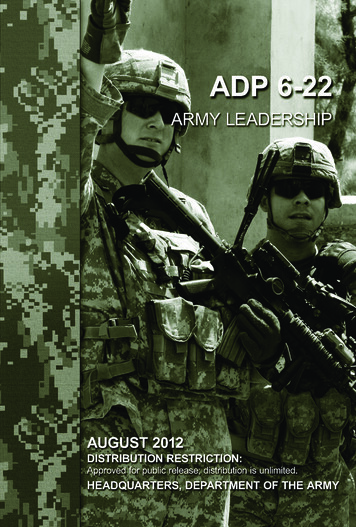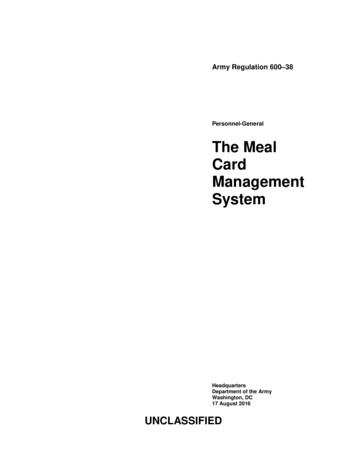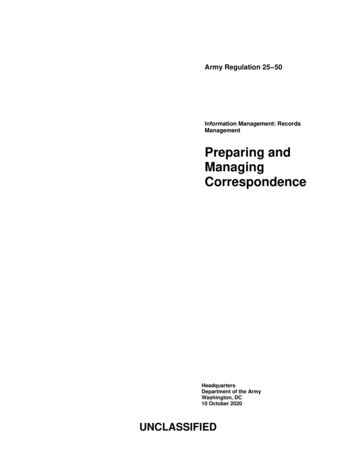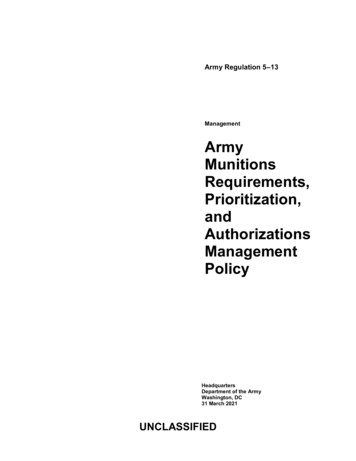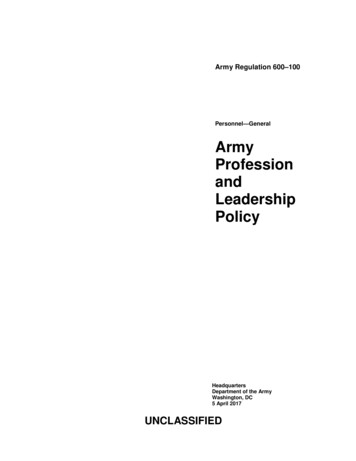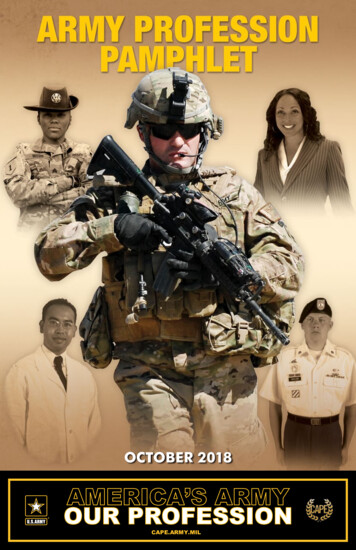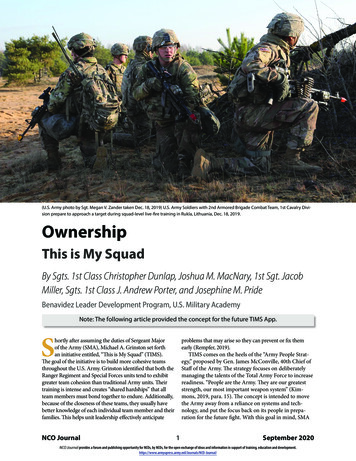
Transcription
(U.S. Army photo by Sgt. Megan V. Zander taken Dec. 18, 2019) U.S. Army Soldiers with 2nd Armored Brigade Combat Team, 1st Cavalry Division prepare to approach a target during squad-level live-fire training in Rukla, Lithuania, Dec. 18, 2019.OwnershipThis is My SquadBy Sgts. 1st Class Christopher Dunlap, Joshua M. MacNary, 1st Sgt. JacobMiller, Sgts. 1st Class J. Andrew Porter, and Josephine M. PrideBenavidez Leader Development Program, U.S. Military AcademyNote: The following article provided the concept for the future TIMS App.Shortly after assuming the duties of Sergeant Majorof the Army (SMA), Michael A. Grinston set forthan initiative entitled, “This is My Squad” (TIMS).The goal of the initiative is to build more cohesive teamsthroughout the U.S. Army. Grinston identified that both theRanger Regiment and Special Forces units tend to exhibitgreater team cohesion than traditional Army units. Theirtraining is intense and creates “shared hardships” that allteam members must bond together to endure. Additionally,because of the closeness of these teams, they usually havebetter knowledge of each individual team member and theirfamilies. This helps unit leadership effectively anticipateNCO Journalproblems that may arise so they can prevent or fix themearly (Rempfer, 2019).TIMS comes on the heels of the “Army People Strategy,” proposed by Gen. James McConville, 40th Chief ofStaff of the Army. The strategy focuses on deliberatelymanaging the talents of the Total Army Force to increasereadiness. “People are the Army. They are our greateststrength, our most important weapon system” (Kimmons, 2019, para. 15). The concept is intended to movethe Army away from a reliance on systems and technology, and put the focus back on its people in preparation for the future fight. With this goal in mind, SMA1September 2020NCO Journal provides a forum and publishing opportunity for NCOs, by NCOs, for the open exchange of ideas and information in support of training, education and ls/NCO-Journal/
Grinston requested that one team from Cohort Five ofthe Benavidez Leader Development Program at the U.S.Military Academy, West Point, New York examine theTIMS concept and predict any problems that may affectteam cohesion as well as offer possible solutions.Five noncommissioned officers (referred to as “Team3”) identified an overarching theme of ownership thatteam and squad leaders should possess to be effective.After Team 3’s discussion and research, it was decidedthe most important factors to focus on to ensure teamswould build cohesiveness would be: in-processing of newSoldiers to teams, noncommissioned officer (NCO) education throughout the Army, “know your people” in order todevelop the individual and the team, and ensuring properleader development. The following sections look at possible solutions the Army could implement to create betterleaders at the lowest level to improve team cohesionthroughout the force.(U.S. Army photo by Sgt. Amada Hunt taken April 23, 2020) U.S.Army trainees with the 434th Field Artillery Brigade conduct physical readiness training during basic combat training at Fort Sill,Oklahoma, April 23, 2020.new Soldier might go through in-processing. Having anassigned sponsor in the Army Career Tracker or a battlebuddy assigned to show someone around is only a smallstep in the overall experience, and one that is sometimesnot done thoroughly (Bugala, 2017).In-processing is a critical time for setting a Soldier upfor successful socialization to their new unit and teamculture. Team culture is defined as “the way a set of people behave and think which stems from the attitudes andbelief system that they all share. A collection of peoplethat are working together to achieve a common goal andobjective” (“What is Team Culture,” 2019, para. 2). Thisforms the basis for how team members interact and thetype of environment in which teams operate. If the squadleader does not take ownership of getting to know newSoldiers and properly introduce them to team membersand culture, they may feel left out. Or worse, the Soldiermay negatively affect the climate of the team, if, for instance, another team member instills the wrong ideas inthe new Soldier’s understanding of the culture. This canlead to issues with team dynamics.To ensure unit leaders understand how to assimilate newSoldiers into the team culture, it is important new membersare trained in positive cultural socialization. It is essentialSoldiers are trained early in their career to be good followers, team members, and leaders. Training in socialization,team/group dynamics, and strong team culture can beapplied in Advanced Individual Training and Basic LeaderCourse. By doing so, junior Soldiers can establish a solidfoundation early to build effective leadership skills.OwnershipTeam 3 looked over a broad list of possible topics communicated from SMA Grinston and concluded that anoverarching theme of ownership applied to the majorityof these topics and is applicable to any unit level in theArmy. Individually, Soldiers demonstrate ownership overtheir physical, mental, and occupational developmentwhile also updating personal records, and other importantaspects of their career. Although individual ownershipis important, successful teams cannot depend solely onindividual ownership to foster full team cohesiveness.Ownership must also be demonstrated by unit leaders,especially at the squad and small group level. Squad andplatoon leaders must take ownership of training, supporting, and caring for the members of their teams.Reception of New Team MembersReception and integration, often referred to asin-processing, is the first moment a Soldier is exposed totheir new team. There are many inconsistencies in how aPromotions and the Noncommissioned Officer Professional Development System (NCOPDS)When a Soldier is promoted into the NCO ranks,they should be transferred out of their current squad orplatoon in order to facilitate fresh leadership dynamics.There is the possibility current team members would stillU.S. Army Soldiers arrive from one station unit training at Fort Benning, Georgia to Fort Riley, Kansas to begin in-processing, April 17,2020. (U.S. Army photo by Sgt. Timothy Brokhoff )NCO Journal2September 2020NCO Journal provides a forum and publishing opportunity for NCOs, by NCOs, for the open exchange of ideas and information in support of training, education and ls/NCO-Journal/
view them as an equal. A newly promoted sergeant should Psychological safety: Can we take risks withoutreceive additional training on organizational socialization,feeling insecure or embarrassed?team dynamics, leadership training, emotional intelli Dependability: Can we count on each other to dogence, and other psychological aspects useful to buildinghigh quality work on time?strong leaders and cohesive teams. Additionally, if the Structure and clarity: Are goals, roles, and execuNCOPDS could accredit their schools and partner with ation plans clear?university or college like the Sergeants Major Academy, a Meaning of work: Are we working on somethingdegree or certification can be accomplished earlier in anthat is personally important for each of us?enlisted Soldier’s career (NCOLCoE, 2019; Woods, 2019). Impact of work: Do we fundamentally believe that theThere is also a need for more relevant evaluation, towork we’re doing matters? (Rozovsky, 2015, para. 5).include self-assessments.The Army has a reasonThere are numerous toolsable amount of focus onused in educational anddependability, structurebusiness settings like theand clarity, meaning ofKolb Learning Style Inwork, and impact of work.ventory that help identifyBut what about the numhow someone learns bestber one factor: psychologifrom experience (Kolbcal safety?& Kolb, 2013). ThesePsychological safety isself-assessments woulda shared belief by all teambenefit all Soldiers andmembers that it is safe tocould be instituted at eachtake risks. This is necessarylevel of NCOPDS. Trainfor strong, cohesive teams,ing young NCOs in theseand leaders need to learnSgt. Maj. of the Army Michael Grinston discusses the future of largepractices will help them tohow to instill and developscale training rotations at the National Training Center, Fort Irwin,be better followers, teamit within their units. EachCalifornia, May 13, 2020. (U.S. Army photo by Casey Slusser)members, and leaders, asteam member must havewell as help them recogconfidence the team willnize and prevent toxic leadership behavior (Departmentnot embarrass, reject, or punish someone for speakingof the Army, 2017). This will allow building positive andup or contributing a new idea.high-achieving team culture quickly at the beginning ofTeams that demonstrate psychological safety are cenone’s leadership career.tered on trust and respect and leaders of these types ofteams do not need to have all the answers. They embraceKnow Your Team, Grow Your Teamhumility, curiosity, feedback from others, and inviteIn addition to instruction, development, andother team members’ opinions, questions, and challengesdiscipline, NCOs are the Army’s first line of care forto current trends and beliefs (Rozovsky, 2015). The mostmost Soldiers. If a squad leader only focuses on miscohesive teams are able to question and give feedback up,sion and discipline, they risk not developing individ- down, and across the hierarchy (Duhigg, 2016).ual Soldiers or the team as a whole. They should takeSo why does this matter to a squad leader, and howthe time to get to know each individual Soldier ondoes it affect knowing their individual Soldiers? Leaderstheir team and establish a personal bond. This bondcan develop their unit cohesiveness by instilling psychowill create trust and make each Soldier feel as if theylogical safety into team culture. By positively buildingbelong to the team.squads at the lowest level, it becomes the foundation forIn 2015, researchers at Google published theirsuccess throughout the Army at every level.findings on Project Aristotle. Over the course oftwo years, they performed a company-wide researchNew Trendsproject to study the effectiveness of teams and findAs a final aspect of leader ownership, Team 3 develwhat drives the most successful teams. Their findoped an idea to aid new Soldiers and squad leadersings showed that the “who” and “what” of the teamalike. The proposal is a mobile device app that could– such as whether the team had one strong leader orrevolutionize how a squad leader receives and intewas more democratic, homogenous or more diverse,grates Soldiers into the team. We would call this appall intelligent and formally educated or not, and“MySquad.” MySquad would encompass all necessaryworking on a simple or difficult task – didn’t matter.elements of a Soldier’s military records, to includeThere were five factors that were consistent in thetheir reception and integration, counseling and ratingmost effective teams. The five factors are:files, training and readiness, photos of their chainNCO Journal3September 2020NCO Journal provides a forum and publishing opportunity for NCOs, by NCOs, for the open exchange of ideas and information in support of training, education and ls/NCO-Journal/
new Soldier arrives, the leadership team would haveaccess to the new Soldier’s information and wouldnot need a computer to work through in-processing.The Soldier’s information could be identified by theirDepartment of Defense ID number or some othermethod of anonymity not tied to personally identifiable information. Encryption would need to be strongenough to protect sensitive information; however,from a user standpoint, it could prove extraordinarilyuseful and efficient.ConclusionIn closing, Team 3 saw ownership as the philosophical backbone that could revolutionize team cohesionin the U.S. Army. If NCOs embrace ownership and theTIMS philosophy of building positive relationships, notonly will this positively affect mission success and unitreadiness, but it will lead to greater Soldier retentionand recruitment of top talent for the U.S. Army. Thiswill ultimately prepare the U.S. Army to succeed in anyfuture conflict or battlefield.U.S. Army Soldiers with the Benavidez Leader Development Program(Team 3), participate in a group meeting, Feb. 19, 2020. (U.S. Armyphoto by Staff Sgt. Courtney Martin)of command, items pertinent to the unit and teamculture, and even an element for anonymous feedback.Ideally, the squad leader, platoon leader, and first sergeant would have new Soldiers automatically uploadedto their own profile by their personnel staff. Once theReferencesis now a branch campus under CGSC. usasma-isnow-a-branch-campus-under-cgsc/Rempfer, Kyle (2019). ‘This is my squad’: SMA Grinstontalks about his push to build cohesive units. TheArmy Times. sh-to-build-cohesive-units/Rozovsky, J. (2015). The five keys to a successful Googleteam. uccessful-google-team/What is team culture in the workplace? (Five ways tobuild company culture). (2019). Open Sourced Workplace. mpany-cultureWoods, J. (2019). Bachelor of Arts now attainable atUSASMA. NCO Journal. uagala, A. L. (2017). Soldiers round up resources to beeffective sponsors. Army.mil. https://www.army.mil/article/182499/soldiers round up resources tobe effective sponsorsDepartment of the Army. (2017). AR 600-100: Army profession and leadership policy. https://armypubs.army.mil/epubs/DR pubs/DR a/pdf/web/ARN3758AR 600-100 FINAL WEB .pdfDuhigg, Charles. (2016). What Google Learned Fromits Quest to Build the Perfect Team. New York TimesMagazine. eam.htmlKimmons, S. (2019). New chief of staff: Taking care ofpeople key to winning the fight. Army.mil. https://www.army.mil/article/225377/new chief of stafftaking care of people key to winning the fightKolb, A., & Kolb, D.A. (2013). The Kolb Learning Style Inventory 4.0 guide. y/the-kolb-learning-style-inventory-4-0/NCO Leadership Center of Excellence. (2019). USASMASgt. 1st Class Christopher Dunlap is a tactical NCO for Company B-2 at the U.S. Military Academy West Point.Prior to West Point, he served as a headquarters platoon sergeant at Fort Shafter, Hawaii. Dunlap has deployed toAfghanistan in support of Operation New Dawn.1st Sgt. Jacob Miller is the first sergeant of the U.S. Army Garrison West Point Military Police Company. Prior to WestPoint, he served as a platoon sergeant with the 551st Military Police Company at Fort Campbell, Kentucky. Miller hasdeployed twice to Iraq in support of Operation Iraqi Freedom and to Germany in support of Operation Atlantic Resolve.NCO Journal4September 2020NCO Journal provides a forum and publishing opportunity for NCOs, by NCOs, for the open exchange of ideas and information in support of training, education and ls/NCO-Journal/
Sgt. 1st Class J. Andrew Porter is a rudimental drummer and drum section leader in the West Point Band’s fieldmusic group, “The Hellcats.” Porter also serves as the personnel and administration NCOIC for the West Point Band.Sgt. 1st Class Josephine Pride is a public affairs mass communication specialist in the U.S. Army. She is servingas the senior enlisted advisor for West Point Public Affairs and has led a combat camera team during a deployment to Afghanistan in support of Operation Enduring Freedom. Prior to West Point, Pride served as an operations sergeant with the 22nd Mobile Public Affairs Detachment at Fort Bragg, North Carolina.Sgt. 1st Class Joshua MacNary is a tactical NCO at the United States Military Academy. Prior to serving at WestPoint, he served as a rifle platoon and mortar platoon sergeant with 2nd Battalion "Patriots", 3rd Regiment out ofJoint Base Lewis-McChord, Washington. He has deployed to Iraq and Afghanistan in support of Operation IraqiFreedom and Operation Enduring /ncojournalofficial/Disclaimer: The views expressed in this article are those of the authors and do not necessarily reflect theopinions of the NCO Journal, the U.S. Army, or the Department of Defense.NCO Journal5September 2020NCO Journal provides a forum and publishing opportunity for NCOs, by NCOs, for the open exchange of ideas and information in support of training, education and ls/NCO-Journal/
Miller, Sgts. 1st Class J. Andrew Porter, and Josephine M. Pride Benavidez Leader Development Program, U.S. Military Academy S hortly after assuming the duties of Sergeant Major of the Army (SMA), Michael A. Grinston set forth an initiative entitled, "This is My Squad" (TIMS). The goal of the initiative is to build more cohesive teams


